On the night of 8th-9th February 1855, a long and meandering trail of mysterious marks was left in the snow across the English county of Devon. The marks resembled hoofprints, somewhat similar to a donkey’s. The intriguing – and disturbing – thing, however, was that the hoofmarks didn’t look like they’d been made by a four-footed animal. The marks mostly appeared in single file, as if some two-legged, upright creature had hopped or jumped. Occasionally, the tracks were double, suggesting the strange biped had ‘merely’ been walking. It didn’t take the local country people long to determine which entity was responsible for the hoofprints. They’d only heard of one creature that had hooves but walked upright like a man. The marks in the snow were soon named ‘the Devil’s Footprints’. And, it would turn, out the Fiend hadn’t finished with Devon – he left more marks, though not in such large numbers, over the following days.
It’s easy to see why this phenomenon so startled the people of Devon. In some villages, almost every homestead had been visited and the hoofmarks went right up the sides of houses and over roofs. They meandered through churchyards and gardens and across fields, sometimes disappearing before starting again a few metres further on, as if the diabolical being had leapt or even flown. Sometimes they’d stop on one side of a haystack and continue on the other, without any hay being disturbed. Elsewhere, the creature had squeezed through tiny holes in hedges or jumped tall fences or impossibly high walls. Two witnesses claimed the footsteps had stopped at the entrance to a pipe just six inches in diameter then reappeared at the other end, a feat many felt had to be supernatural as no animal large enough to produce such prints could have wriggled through that tube. The prints apparently halted before the Exe estuary – a two-mile-wide span of water – then casually started again on the opposite bank.
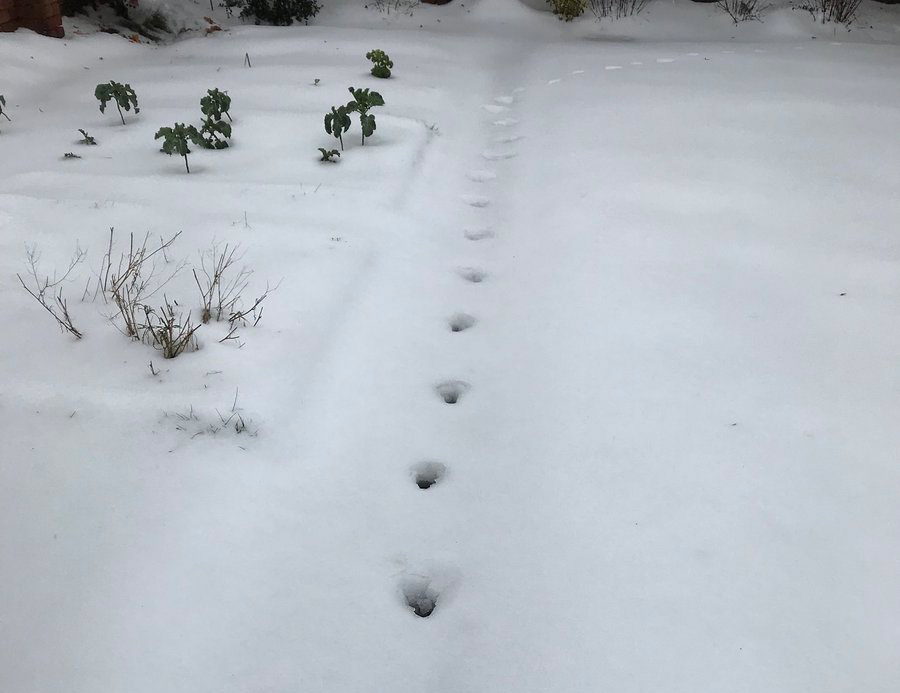
Many gardens and fields were marked with mysterious single lines of ‘Devil’s Footprints’. (Photo: Claire Witham)
There was also the sheer length of the beast’s damnable journey. Though accounts varied, it was estimated that the being must have walked between 40 and 100 miles on the night of 8th-9th February – an accomplishment no earthly creature could manage. The footprints seem mainly to have been concentrated in south and east Devon, travelling from Exmouth to Topsham then across the Exe to Dawlish and Teignmouth. Some stated that the prints had appeared as far south as Torquey and Totness, as far north as the outskirts of Exeter and as far east as Weymouth in Dorset. The Devil’s Hoofmarks did, however, show some variation. Within some the impress of a horseshoe could be seen; other hoofprints boasted claw marks, lending credence to the notion of their infernal origin.
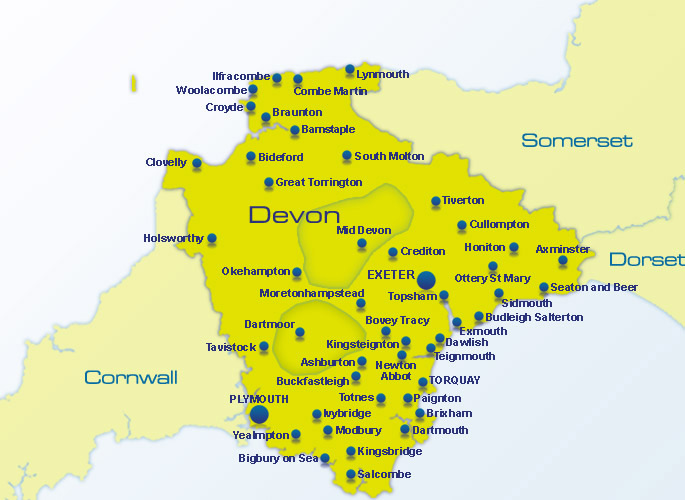
Map of Devon – the Devil’s Footprints appeared mainly in the south and east around the Exe estuary.
News of the Devil’s Footprints soon spread through Devon and beyond. Articles appeared in The Times and in the local press. The Illustrated London News published a series of letters speculating about what could have caused the demonic imprints. These reports betray the terror – mingled with curiosity – that many locals felt. Residents, sometimes in armed groups, followed the footprints. Some traced the marks for miles, though without discovering much that could explain them. It’s, however, claimed that one local hunt tracked a mysterious beast to a wood near Dawlish. The huntsmen sent in the hounds to corner the creature, but the dogs soon ‘came back baying and terrified’.
The Western Luminary and Family Newspaper stated the footprints had created ‘an uproar of commotion’ while according to The Times a ‘considerable sensation has been evoked in the towns of Topsham, Lympstone, Exmouth, Teignmouth and Dawlish, in the south of Devon … the superstitious go so far as to believe that they are the marks of Satan himself … great excitement has been produced among all classes … many superstitious people in the above towns are actually afraid to go outside their doors after night.’ A letter in Woolmer’s Exeter and Plymouth Gazette said, ‘The poor are full of superstition and consider it little short of a visit from old Satan or some of his imps’. The Western Times related that Exmouth had been ‘thrown into a state of alarm, in consequence of a report that the town and neighbourhood had been visited in the night by no less a person than his Satanic Majesty, and that the marks of his feet were distinctly to be seen imprinted on the snow.’
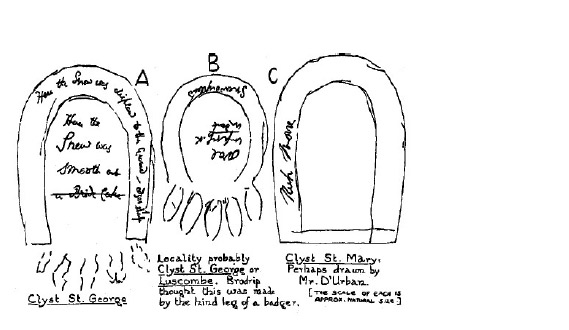
Various sketches of the Devil’s Footprints made by eyewitnesses, from the papers of the Devon vicar the Reverend H.T. Ellacombe
Not everyone agreed the Devil’s Footprints had supernatural causes. Journalists, naturalists, clergymen, and the more educated who looked down on their superstitious neighbours were soon coming up with theories to explain the sinister occurrence. Later writers have also tried to identify who or what made the marks. Possible culprits have ranged from untethered balloons, to swans clad in padded shoes, to badgers, otters, and escaped kangaroos and monkeys. Some have blamed weird weather patterns; others have suggested UFOs and sea monsters. Some have seen a human influence at play – from attempts by austere Protestants to frighten religious opponents to Romany Gypsies on stilts creating the marks to scare off rival bands of Travellers.
The Devil’s Footprints were certainly a strange case. Let’s look at the explanations that have been put forward and try to make some sense of this diabolical conundrum.
Donkeys, Badgers, Cats – Could an Ordinary Animal Have Made the Devil’s Footprints?
Accounts from the time describe the Devil’s Footprints as between three-and-a-half and four inches long and around three inches wide. The marks were mainly in single file, rather than alternating to the left and right as the prints of humans and many animals would. The distance separating the marks was small, between eight and 16 inches, suggesting either short hops or an almost mincing gait. If these marks could have been made by some land animal rather than ‘His Satanic Majesty’, we must enquire if any creature common in the British Isles might have produced them.
Most of the marks were cloven and traces of horseshoes were found within some so we should start by asking whether the imprints may have simply been left by donkeys or ponies. People at the time noted that the marks indeed looked like the hoofprints of such animals. The Western Luminary and Family Newspaper described the marks as ‘exactly, in shape, like a donkey’s hoof’ while The Times stated ‘the impression of the foot closely resembled that of a donkey’s shoe’. The possibility that such a creature might have left the prints, though, was quickly dismissed due to the layout of the marks. As The Western Luminary put it, they were ‘evidently done by some two-footed animal’.
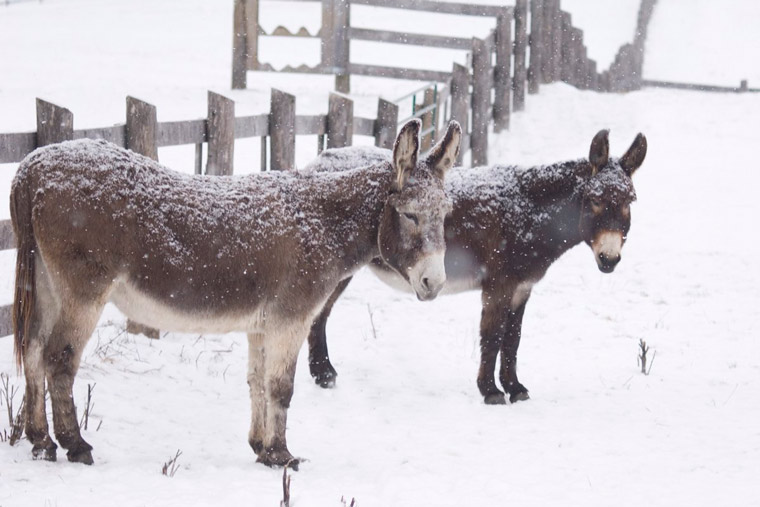
Might humble donkeys have made the Devil’s Footprints in Devon? (Photo: The Donkey Sanctuary of Canada)
But donkey prints can be deceptive. According to the researcher Theo Brown, ‘donkeys are the only animals that plant their feet in an almost perfect single line’, a fact that has led her to conclude that at least some of the Devil’s Footprints were made by such creatures. Though this might seem an easy answer to our mystery, the idea the prints were left by donkeys conjures up some tricky questions. Human steps weren’t seen alongside the Devil’s Hoofmarks and it’s unlikely that people would have led or ridden donkeys in the thick of a winter night through gardens and churchyards and across expanses of private land. Most of these theoretical donkeys must have, therefore, strayed and several such beasts would have needed to escape simultaneously to produce the quantities of marks seen. Also, there’s no way that donkeys could have trotted up the walls of houses or slithered through narrow pipes. And the creatures are unlikely to have walked over roofs.
We might also question why country people wouldn’t have recognised donkeys’ trails. To this objection, it might be said that significant falls of snow are uncommon in south Devon, an area with one of the most temperate climates in Britain. Might locals, agitated by the less explicable marks – such as those going up houses – have then seen the prints of stray donkeys in the unfamiliar snow and decided they were more sinister than they actually were? In opposition to this idea, we must consider a letter sent to The Illustrated London News by a correspondent calling himself ‘South Devon’, who gave the impression of being an veteran countryman who’d also spent time in Canada and who’d ‘much experience of tracking wild animals and birds upon the snow’. South Devon claimed that on the morning of 9th February the prints of well-known creatures were recognisable as ‘the snow bore the fresh marks of cats, dogs, rabbits, birds and men clearly defined’ and that – unlike the Devil’s Footprints – they excited little comment. South Devon did admit that the Devil’s Footprints ‘were the perfect impression of a donkey’s hoof’, but stressed that ‘foot had followed foot in a single line’ and that no known animal walks in a ‘line of single footsteps, not even man’. This suggests South Devon – and perhaps others in the area – were actually unaware of how donkeys’ hoofmarks can appear in snow.
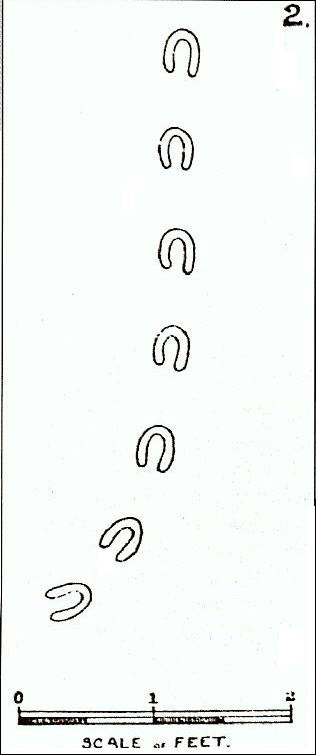
A sketch of the Devil’s Footprints – sent in by the correspondent ‘South Devon’ – which appeared in The Illustrated London News
Though stray donkeys might well have made some of the hoofmarks, they can’t account for them all. Another creature accused of making the diabolical imprints was the humble badger. Also in a letter to The Illustrated London News, the well-known naturalist Richard Owen put the blame on this seemingly innocent animal. Owen emphasised that badgers are not only nocturnal but can travel significant distances while looking for food, especially in winter. Badgers also have long claws and claw marks were spotted in some of the Devil’s Hoofprints. The pawprints of badgers are, however, staggered and the creature has quite a large tread, meaning it would almost certainly leave a double line of marks. It’s also somewhat comical to imagine stout and sturdy badgers scaling walls, strolling across rooftops, and springing over haystacks and high fences.
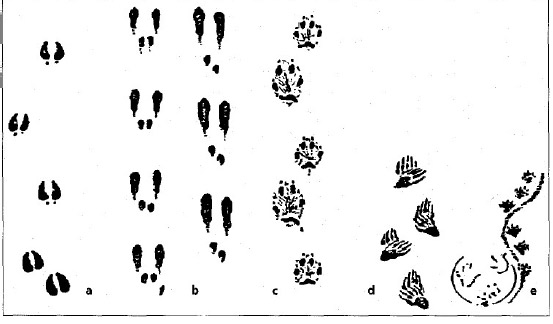
Trails of animals that may have been mistaken for the Devil’s Hoofmarks: a. Whitetail deer; b. Cottontail Hare; c. Fox; d. Badger; e. Otter
Another everyday animal blamed for the Devil’s Footprints was the cat. On the morning of 9th February, the tenant of Aller Farm in Dawlish discovered that the night’s strange weather had distorted some pawprints his cat had left in the snow. Snow had come down heavily around midnight, but towards dawn there’d been a slight thaw and some rain. The temperature had then dropped again and there’d been a frost. Such melting and refreezing had warped the steps of the unassuming moggie ‘into the shape of a small hoof, with still the impression of the cat’s claws enclosed’. The tenant reported this to the Reverend Edward Fursdon, the vicar of Dawlish, who presumably noted it down.
The association of cats with the Devil’s Footprints is an interesting one. Cats can spring considerable distances, perhaps accounting for some of the (smaller) breaks in the lines of imprints. They’re also excellent climbers, which could maybe explain some of the marks on the sides of houses, although such prints would be unlikely to be in single file. (Also, except where snowdrifts had accumulated, the prints on house sides are likely to have been muddy ones rather than stamped in snow and so would have been recognisably feline.) Cats, though, have certainly been known to saunter across roofs. And while cats don’t create trails as linear as donkeys’, the prints of cats – and other animals like foxes – can give the impression of being in single file. Devon’s farms and villages in the mid-1800s no doubt contained lots of cats so the distorted tracks of domestic moggies might account for some of the Devil’s Footprints. It’s unlikely, however, that many cats would have taken it upon themselves to embark on journeys miles long through the snow.
More Possible Culprits for the Devil’s Footprints – Hopping Mice, Otters, Squirrels, Toads, Monkeys and Kangaroos
Yet more animals have been identified as possible creators of the Devil’s Footprints. On 8th March 1855, the Exeter Flying Post suggested the key to the mystery might be found in the form of the lowly toad. The paper reported that a Torquey man had followed a curious trail through his garden and found a large toad sitting by a tree stump at its end. It’s, however, unclear if it was the toad that made the tracks or if it just happened to have positioned itself where they stopped. It’s also uncertain whether the Devil’s Footprints did indeed extend as far south as Torquey despite what some claimed. Toads have webbed feet so it’s unlikely their trails would match the descriptions of the Devil’s Footprints unless weather conditions had substantially distorted them. The creatures can, though, presumably hop through pipes – perhaps providing an answer to the conundrum of the six-inch tube.
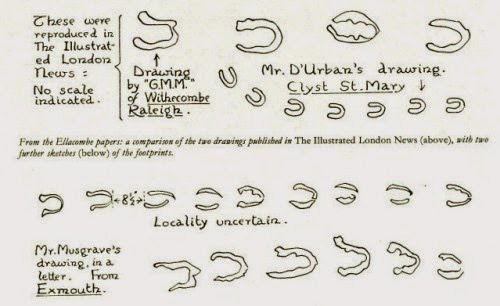
Comparison of eyewitnesses’ sketches of the Devil’s Footprints, made in Devon, England, from the papers of the Reverend H.T. Ellacombe
Other animals skilled at hopping, springing and jumping have been accused of making the diabolical marks. The Inverness Courier newspaper argued the Devon prints were made by a hare, as similar marks found near Inverness were thought to have been created by a hare or polecat. It remains unclear, however, whether such creatures really did leave those puzzling tracks near the Scottish town.
Rats, mice and other rodents sometimes engage in hopping and so have been viewed as possible causes of the Devil’s Footprints. In a letter to The Illustrated London News, one Thomas Fox wrote that he’d found tracks in his brother’s garden similar to those in Devon and suspected rats may have made them. In the 1950s, the zoologist Alfred Leutscher stumbled upon similar markings in Epping Forest. Leutscher knew that certain animals – including rabbits, hares, squirrels, mice and rats – sometimes leap with all four feet together. If there’s sufficient snow, their traces can resemble hoofmarks and Leutscher argued this effect is enhanced if the impressions thaw then refreeze. He believed only one animal, though, would have been the right size to make the Devon marks – the wood mouse – and claimed to have observed tracks left by this creature in Epping Forest that matched descriptions of the Devil’s Footprints. But – though wood mice might have made some of the Devon imprints – it seems unlikely that wood mice or other rodents would hop for such long distances rather than walking or scurrying or that single creatures could have made the trails that Devon villagers followed for miles.
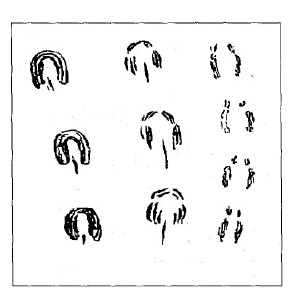
Thomas Fox’s sketch of ‘rat prints’ in his brother’s garden – might this animal have left the Devil’s Footprints?
A more outlandish explanation for the Devil’s Footprints involved a hopping creature of a more exotic type. There were claims two kangaroos had left the marks after escaping from a private menagerie in Sidmouth. A Reverend G.M Musgrave seems to have been the first to put forward this idea, expounding it in a sermon. A letter to the Exeter and Plymouth Gazette outlined how ‘on Sunday last, the Rev. Musgrave, delivered one of his usual eloquent discourses in Lympstone Church, and in speaking of Satan as a tempter, who was continually besetting our path, though invisible, aptly alluded to this mysterious visitor who had left behind him visible evidence of his presence and expressed it as his opinion that the foot-prints were those of the kangaroo: but it must have been a busy animal indeed to have played up such pranks as this creature has done.’ Though kangaroos could have bounded over certain obstacles, even these incredible creatures would have struggled to get onto rooftops or leap high walls. Kangaroo prints are in no way similar to hoofmarks and the distance bounced by kangaroos certainly exceeds 16 inches, the maximum span recorded between the Devil’s Footprints. While there were indeed two kangaroos in the Sidmouth menagerie, there’s no evidence either of them escaped.
The Reverend Musgrave later admitted he came up with the kangaroo story to calm his congregation, who’d been terrified by the Devil’s Footprints. In March 1855, he sent a letter to The Illustrated London News: ‘the state of the public mind of the villagers … dreading to go out after sunset … under the conviction that this was the Devil’s work … rendered it very desirable that a turn should be given to such a degraded and vitiated notion … and I was grateful that a kangaroo served to disperse ideas so derogatory.’
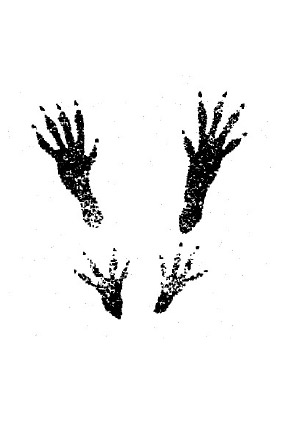
Illustration of the tracks of a jumping wood mouse by Alfred Leutscher in his book Tracks and Signs of British Animals (1960). Might weather conditions have merged such marks into the Devil’s Footprints?
An even more incredible suggestion was that the marks were left by a monkey that had escaped from a menagerie or circus. A monkey might have had the agility to climb walls and skip across roofs, but a single monkey couldn’t have left so many footprints in one night and – again – there’s no evidence of such a creature absconding around the time the Devil’s Footprints appeared.
A more sensible notion is that otters caused some of the marks. Cold weather might have driven such creatures away from their frozen rivers and streams in search of food and all the places where the Devil’s Footprints were found were within half-a-mile of such watercourses. Even in the mid-1800s, otters weren’t common creatures so many country people may have not recognised their trails. The two witnesses who saw the prints near the pipe suspected an otter might have squeezed through it and they noticed the creature that had made the marks had slunk under low branches, like an otter would. In addition, crossing the Exe estuary would have probably not presented much of an obstacle to these semi-aquatic animals. Though some of the demonic prints may have been made by otters, it’s unlikely these creatures could have left them all, especially those running up walls or over rooftops.
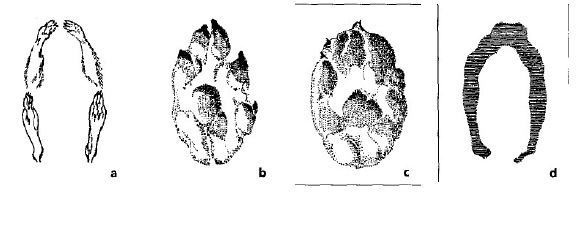
Animal prints in Rupert Gould’s book Oddities (1928): a. Thomas Fox’s ‘rat prints’; b. Hind foot of an otter; C. Badger’s hind foot; D. One of the Devil’s Hoofmarks
It may be that a variety of animals were responsible for the Devil’s Footprints. Their marks may have been made somewhat more uniform by the thawing and refreezing action of the weather (though the extent of the similarity of the prints still raises questions). Early 1855 did see exceptional cold – the winter had been so intense that ‘the thermometer was one degree lower than has ever been known before by the oldest inhabitant’ and stretches of the rivers Exe and Teign froze over, allowing games and even a feast to be held on the ice. Such conditions could have driven animals to adopt unusual behaviours, travelling further in their search for food and leaving longer trails. These trails – in the excitable minds of some – could have merged into evidence of an epic trek, a journey so outlandish it could only have a supernatural explanation.
There are still many questions, however, about the Devil’s Footprints so we’ll leave behind the animal realm for now and look at the activities of birds, balloons and humans.
Might Birds Have Been Responsible for the Devil’s Footprints?
It might seem a rather obvious assertion that birds were to blame for some of the prints. Most bird species would have no trouble flapping over haystacks, walking across roofs, entering walled gardens or clearing the Exe estuary. Smaller varieties could have navigated pipes and got through holes in hedges. There’s also evidence that the freezing weather caused flocks of seabirds to come inland, which could explain why similar prints were found across a large area. The breaks in the lines of prints may have been caused by birds flying short distances before coming down and walking again.
The problem with this argument is that the feet of birds – whether clawed or webbed – leave prints that in no way resemble hoofmarks. Some have claimed the birds’ feet might have iced up, giving their tracks an unusual shape. One Reverend H.T. Ellacombe did apparently notice flurries in the snow around some of the Devil’s Footprints – flurries iced-laden birds may have created by beating their wings as they tried to take off. But it’s improbable that even iced-up bird feet would have left impressions like hoofmarks. It is possible, though, that already agitated observers – viewing, from some metres away, bird prints on roofs distorted by thawing and freezing – could have seen them as grim evidence the Evil One had visited.
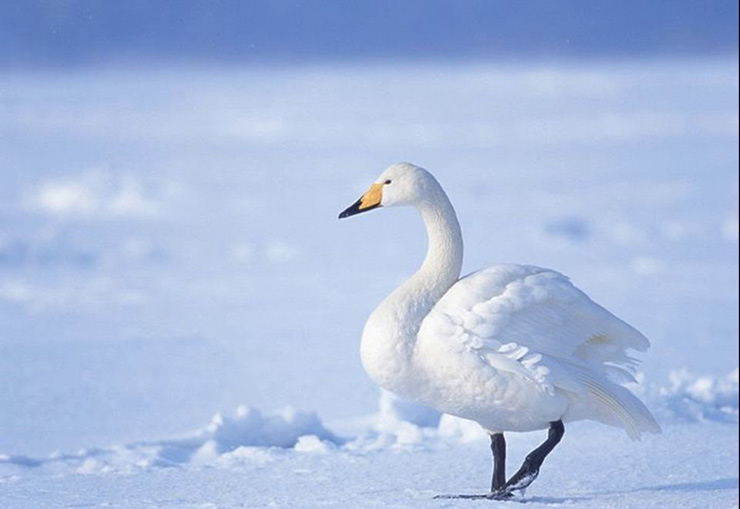
Could birds have caused Devon’s Devil’s Footprints? (Image: Greg Williams)
An entertaining, though improbable, suggestion is that a domesticated swan sporting padded shoes caused the Devil’s Footprints. An escaped – and very much exhausted – swan is rumoured to have been caught at St Denis, near Paris, five days after the Devon footprints appeared. A silver collar round the swan’s neck showed it had come all the way from Germany, from ‘the domain of Prince Hohenlohe’. The bird’s feet were apparently padded to stop it damaging ornamental gardens and lawns. Swans can fly large distances, but it’s unlikely that even the most vigorous swan would have crossed the channel, flown all the way to Devon, left hundreds of thousands of footprints in one night then headed back to the Continent. A whole flock of such birds would have needed to abscond to produce the amount of prints seen.
Could a Stray Balloon Have Left the Devil’s Hoofmarks?
According to the novelist Geoffrey Household (1900-1988), an experimental balloon produced the Devil’s Footprints. The balloon, kept at the naval base Devonport Dockyard, somehow got free and set off on a journey across the countryside. The balloon carried two shackles on the end of its mooring ropes and these caused the balloon to continually dip down. It was these shackles – making frequent contact with the snow – that pitted Devon with its trail of curious marks. Household’s source was one Major Carter, a local man who’d heard the story from his grandad, an employee at the Devonport base. Carter’s grandfather told him that the incident had been hushed up because the balloon had damaged conservatories and shattered greenhouses and windows. The balloon finally ceased its flight at the east Devon town of Honiton.
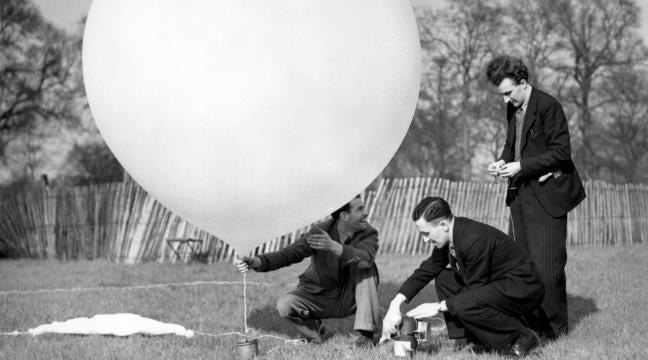
Might an experimental balloon like this one have caused Devon’s Devil’s Footprints?
The balloon theory would explain how the Devil’s Footprints had got on roofs and how the entity that made them had bounded over haystacks and walls. It could also account for the gaps in the trails and the crossing of the Exe, during which the shackles would have presumably just hit water. It’s likely, however, that the balloon’s mooring ropes would have left marks in the snow too and there are no records of any such imprints. The balloon also would have probably sooner or later become tangled in a tree, bush, hedge or other obstruction. It seems more likely that the balloon story was invented after the appearance of the Devil’s Footprints as an attempt to explain them.
Might the Devil’s Hoofmarks Have Their Origin in a Religious Dispute?
One explanation for the Devil’s Footprints is that they were left as a hoax, a somewhat sinister prank arising out of disputes within the Church of England. The Church at the time was divided between High-Church followers of the Oxford Movement and more puritanical Low-Church Anglicans. The Oxford Movement – put simply – sought to reintroduce medieval elements into Anglicanism, with a stress on ritual, vestments, incense and the beauty of worship and the belief that religious services should be whole-body experiences rather than just appealing to the intellect. To more radical Protestants, this smacked too much of Catholicism and they wanted more focus on the Bible and sermons, with churches and ceremonies kept plain and austere.
Some suspect the Puritans – feeling their opponents were basically in league with the Devil – used the snowfall as an opportunity to frighten them. With some sort of implement – perhaps a horseshoe attached to a long pole – they made trails in the churchyards of vicars who supported the Oxford Movement, as well as across the landscape more generally. The use of such an implement might explain the marks going up houses, emerging from pipes, and on either side of undisturbed haystacks. It could also account for the similarity of many of the imprints. If an implement had been employed, however, one might expect all the Devil’s Footprints to be identical – which they weren’t – though thawing and refreezing may have distorted some.
The main objection to such a theory lies in the sheer number of marks – it would have taken a conspiracy of hundreds of Puritans to produce so many. What’s more likely is that – noticing the commotion the Devil’s Hoofmarks had caused – some Puritans took advantage of the uproar to make a religious point. This might explain the prints found in Topsham Churchyard on 13th February – several days after the bulk of the marks had been discovered on the morning of the 9th. Ominously, the tracks at Topsham went up ‘to the very door of the vestibule’. Though the vicar at Topsham was High Church, not all the churches where prints were found had vicars who adhered to the Oxford Movement. At Dawlish, a more Puritan parish, hoofmarks led ‘from the vicarage to the vestry door’ and prints were discovered ‘all over the churchyard and between the graves’.
Interestingly, the trauma of religious disputes does sometimes give rise to alleged experiences of the supernatural. For instance, a vampire legend in Croglin, Cumbria, may have its roots in the religious conflicts that arose around the time of the English Civil War. The Croglin legend even includes rumours of a vampiric bat flying out of the tomb of an unpopular clergyman.
Might the Devil’s Footprints Have Been Made by Gypsies on Stilts?
According to the autobiography of Manfri Frederick Wood In the Life of a Romany Gypsy (1973), the Devil’s Footprints were made as part of an elaborate plan hatched by Gypsies to frighten off rival travelling groups. Rather than Devon, Wood places the incident in Somerset though he admits, ‘I am not sure about the exact area or even the approximate date when this occurred – but it is a true story as I got it from one of my uncles and it filled the newspapers at the time and caused a great sensation.’
Wood goes on: ‘That night, as everybody in the area found first thing in the morning, the Devil walked right across the county of Somerset. Only it wasn’t the Devil at all but some seven Romany tribes using over 400 sets of measure stilts with size-27 boots at their base. The whole operation took over 18 months to plan and prepare.’
The issue the Romanies had was they felt their territory was being overrun by Didekais (people of part-Romany heritage) and ‘Pikies’. (‘Pikey’ is generally a derogatory term for Gypsies and Travellers, but in Wood’s account it probably refers to non-Romany travelling people.) The idea was to frighten away these competing groups by exploiting their fear of ‘the Mulo’. According to Wood, in Gypsy lore a Mulo is a vampire-type figure that ‘came out of its tomb every night as the dead man’s double’ and would also emerge for half-an-hour at high noon. Gypsies had once been so terrified of the Mulo that they ‘made a point of stopping at a camping site in time to get out of the Mulo’s way inside their tents or wagons. So the old Gypsies years ago never travelled at noon and were out of sight by dusk.’ Some Gypsies, though, saw the Mulo not as a revenant of a dead man but rather as the Devil in the deceased man’s guise.
Wood states that, having long ago converted to Christianity, most ‘of the pure Romanies in this country no longer bother about Mulos and travel at any time of the day or night’ whereas ‘a good many of the Didekais and Pikies are still very particular about keeping out of the Mulo’s way. In our family, the belief in Mulos was a very useful weapon for clearing an area more or less permanently of Pikies.’
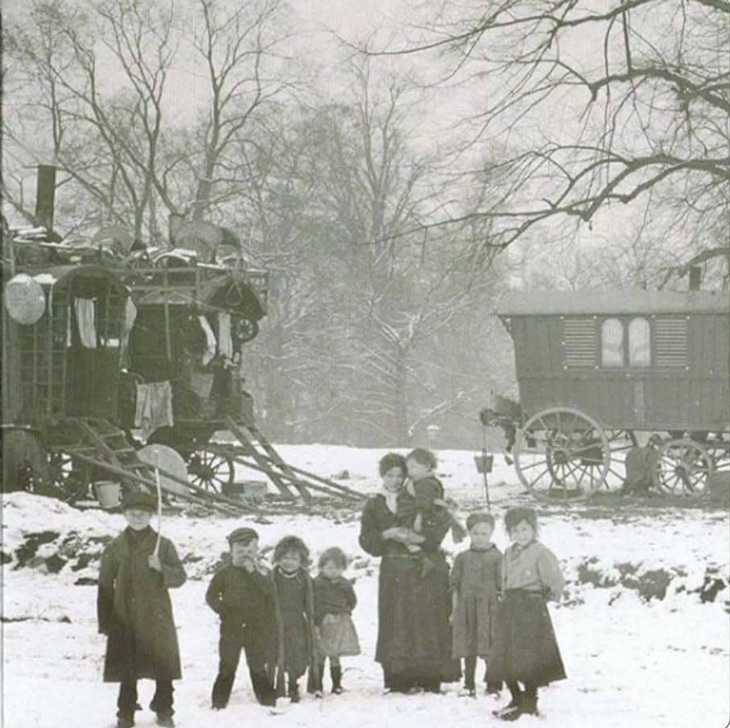
A group of Gypsies in the snow – could Romanies have created the Devil’s Footprints?
The ‘measure stilts’ the Romanies used ‘consisted of a pair of step ladders that could be lengthened or shortened by means of slides and hinges. They were joined at the top by a wheel. The bottom of the step ladder stood in the great big boot and the man operating the stilts stood on one of the ladders and joggled about on it to make as deep a foot impression as possible. Then he would either swing the second ladder over the top by the wheel – if there was enough head room – or … he would raise the ladder by the slide and move it forward in one “Devil’s stride”. Either way, he got an exact measure of a stride, as the measure stilts were constructed so they could not over- or under-stride the three yards it was meant to do.’ In order to avoid being spotted when on public highways, the stilt-walkers would ‘throw a sheet over the whole works so the Devil would be seen walking rather than a man with ladders.’
The Romanies made it look as if the Devil had walked ‘right across Somerset in as straight a line as possible’, which even meant that ‘his footsteps had to go straight up one wall’ of any building in his path then ‘over the roof and down the other wall. The stilt-walker could not walk up walls – he had to straighten out his stilts to turn them into a long ladder and then make a muddy line of “devil’s strides” … Halfway over the top, he had to hoist the ladder up and swing it right round, and without too much noise, to the other side of the building. This was the snaggiest part of the whole business as it required exceptional strength and poise.’
Apparently, ‘the route was planned very carefully and every part of it studied … When the plan was put into operation, it went off without a single hitch … The next day, the Devil’s Footprints could clearly be seen along the whole route. It put the fear of God into all the locals – but that was not the point of the exercise. For the next few years it kept the area free from Pikies and Didekais who swore blind it was a Mulo that had crossed and they were not going to take any chances.’
As strangely fascinating as this account might be, this explanation for the Devil’s Footprints has flaws. Wood places the incident in Somerset rather than Devon (though he admits his memory may be faulty with regards to location). The size-27 boots the Gypsies attached to their stilts would have produced prints far bigger than the Devil’s Footprints and of a different shape. The stride between the marks left by the Romanies would have also been much larger. In addition, the Romanies made their trail in a straight line whereas many of the Devon tracks meandered. It’s difficult to believe that 400 people traversing the countryside on stilts wouldn’t have set dogs barking or that at least some of them wouldn’t have been apprehended or had accidents. There’s also no evidence – as far as I know – of Gypsies elsewhere using similar techniques to clear areas of rivals.
One detail might, however, hint that stilt-walkers could have left some of the marks. In 1889-90, the journal Notes and Queries discussed the Devil’s Footprints and one correspondent claimed that the impression of ‘a point of a stick’ had been left at lengthy but regular intervals besides the prints. Could such sticks have helped stilt-walkers balance? This detail was, however, reported decades after the footsteps appeared and the fact the stick-marks were regular wouldn’t fit with someone using such an implement whenever they feared they might topple over.
I suspect that the Devon incident entered Gypsy folklore and that the telling of the tale became ever more elaborate and ever more intertwined with Romany history as the years passed. Or perhaps – like the Puritans above – the Romanies heard of the Devil’s Footprints and hoaxed more marks (though on a smaller scale than claimed) to serve purposes of their own.
Could the Devil’s Footprints Have Been Formed by Weird Weather Patterns?
Another possible cause for the Devil’s Footprints was proposed by the Scotsman J. Allan Rennie. Rennie suspected the footsteps had been made by a strange weather phenomenon, one he claimed to have witnessed. In 1924, in northern Canada, Rennie saw a line of mysterious tracks in the snow while crossing a frozen lake. His companion, ‘a French-Canadian dog skinner’, became agitated, blaming the prints on a monster called the Windygo. So disturbed was the dog skinner that he deserted Rennie’s expedition. Not long afterwards, it was Rennie’s turn to be petrified. He saw tracks approaching him in the snow though no visible creature seemed to be making them:
‘The tracks were being made within 50 yards of me – 20 – 10 – then smack! I shouted aloud as a large blob of water struck me in the face. I swung around, brushing the moisture from my eyes, and saw the tracks continuing across the lake.’
When he’d recovered from the shock, Rennie reasoned that the prints had been caused by ‘some freakish current of very warm air coming into contact with the very low temperature which had set up the condensation.’ Rennie claimed to have observed similar tracks in Kent in 1939 and in Strathspey, Scotland, in December 1952 and January 1953.
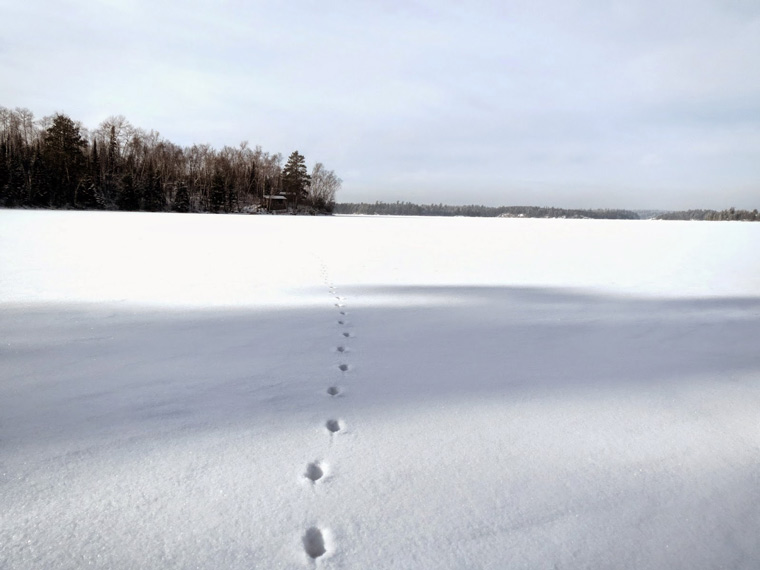
Did a strange weather phenomenon cause Devon’s Devil’s Footprints?
If such a phenomenon does exist, it could explain the Devon marks left in difficult-to-access places like rooftops, and presumably walls and high fences wouldn’t present obstacles to currents of air. The prints Rennie observed, however, travelled in straight lines rather than meandering as in Devon and were bigger than the Devon marks. Those Rennie saw in Canada looked as if snowshoes had made them while the marks in Strathspey were 19 inches long, 14 wide and 7 feet apart. Furthermore, meteorologists are dubious about whether air currents could produce such tracks. Those the naturalist and author of Animal Legends (1995) Maurice Burton consulted declared such claims ‘impossible’.
So What’s the Conclusion – What Did Cause the Devil’s Footprints?
This post shows that an incredible range of causes have been suggested for the Devil’s Footprints – from kangaroos, to stray balloons, to hopping mice, to Devil-obsessed Puritans to Gypsies teetering on stilts. But even more outlandish ideas have been proposed. In 1972, one George Lyall, writing in Flying Saucer Review, asserted a UFO had made the prints, by hovering over Devon and firing laser beams at the snow, apparently as part of a measuring exercise. The ex-navy officer Rupert Gould, on the other hand, put forward the idea that an unknown sea creature had emerged from the ocean to leave the marks. Gould’s theory mainly relies on the fact that all the prints appeared close to the sea or the Exe estuary. He also noted that pony-like footprints had once been found on the Antarctic Kerguelen Islands, at a time when that territory had no land animals.
Leaving aside the more offbeat suggestions, might we attempt a hypothesis for the Devil’s Footprints? No one explanation is completely satisfactory, but perhaps a combination of some of the ideas above could go some way towards accounting for the diabolical marks. I suspect most of the footprints were left by a variety of animals. Stray – or ridden – donkeys are likely to have created some, hence the hoofprints with horseshoes. Other marks could have been caused by creatures such as cats, otters and badgers or by the hopping of toads, mice, rats and other rodents. The thawing and refreezing that occurred on the night of 8th-9th February might have then distorted these prints into hoof-like shapes. Additional marks – also distorted and seen from a distance – could have been left by birds, which might account for some of the prints on roofs and on opposite sides of high walls and haystacks. The extreme cold weather might well have driven animals to stray from their regular territories and travel farther in search of food, meaning prints appeared where they wouldn’t normally. Though the correspondent South Devon claimed that the marks of ordinary animals were also visible in the snow and caused no excitement, these could have been left after the melting and refreezing that distorted earlier steps.
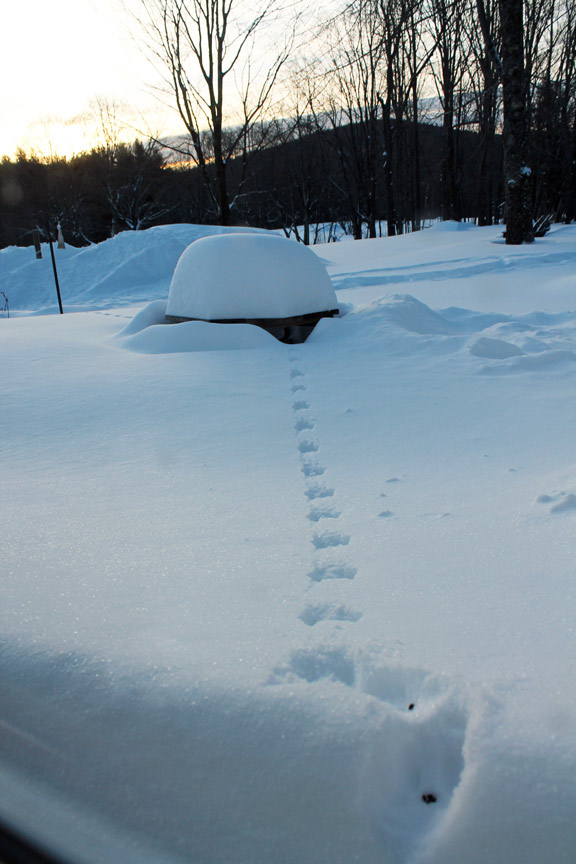
Marks in snow made by a red squirrel – could some of the Devil’s Footprints have been left by hopping rodents? (Photo: Fortpelhamfarm)
Observing the commotion these unusual prints provoked, human pranksters could have then created more over the next few nights. The activities of such people might account for those marks leading ominously up to churches or walking straight up house walls. The hysteria the Devil’s Footprints triggered also likely led to descriptions of them being exaggerated and over the years memories of the phenomenon were probably embellished further.
Even eye-witnesses at the time may have been prone to exaggerate. South Devon, for instance, rather than being a mature countryman was later revealed to be the 19-year-old William D’Urban, who’d go on to be the first curator of the Royal Albert Memorial Museum at Exeter. D’Urban was responsible for getting certain notions into the press: that all the marks were ‘exactly the same size and the step the same length’ (which, as we have seen, wasn’t quite true), that the prints extended for 100 miles (others estimated it was more like 40), were in a straight line (they often meandered) and were found as far south as Torquey and Totness. South Devon also mentioned a 14-foot wall being jumped and prints on the roofs of houses. It’s possible that youthful enthusiasm gave extra colour to South Devon’s account and some of his contemporaries did dispute his claims. The Reverend G.M. Musgrave (he of the ‘kangaroo theory’) wrote to The Illustrated London News about South Devon’s assertions: ‘The outline accompanying your intelligent correspondent’s recital of the circumstances hardly conveys a correct idea of the prints in question.’
As for the excitable account of hounds being terrified by a sinister creature near Dawlish, suggestions have been made that the passage of time has in fact enhanced a different tale – that of the hunt closing in on nobody more threatening than a village idiot. This imbecile – who was fond of ‘decking himself in layers of chicken and goose feathers’ and roaming through woods imitating animal noises – was almost lynched by the nervous party. With regards to the footprints’ audacious crossing of the Exe, the river is two miles wide only where it meets the sea. It can be waded across in places at low tide and may have even been frozen on the 8th-9th February, meaning many animals could have crossed it without occult help.
Phenomena similar to the Devil’s Footprints have been observed elsewhere, suggesting that certain combinations of circumstances may produce marks like those seen in Devon. In 1922, the Daily Mail reported that tracks ascribed to the Devil had appeared in Norfolk and the Cotswolds, including on rooftops. In January 1855, prints similar to a deer’s were discovered on the walls and roofs of several pubs near Wolverhampton. (The fact only pubs were targeted might suggest local moralists were responsible.) In 1957, cloven prints – 12 inches apart – were found in a Hull back garden. Prints found in Belgium towards the end of World War II are said to have run for two miles ‘in a dead straight line’. In March 1855, The Times reported that hoofmarks manifested annually in the snow on a certain hill in Russian Poland. Locals blamed the hoofmarks – which, if no snow had fallen, would appear in the hill’s sandy soil – on malign supernatural influences. Though the Devon case is the most famous – and seems the most extensive – example of mysterious footprints, the fact it isn’t the only one could indicate that natural conditions – with perhaps some added human hoaxing – may occasionally result in such spooky occurrences.
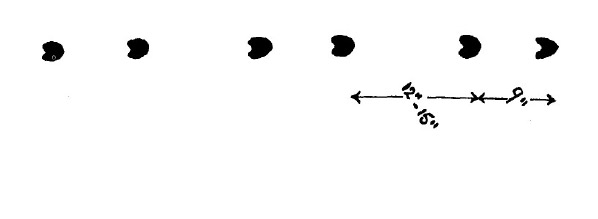
Mysterious tracks sketched in Belgium towards the end of World War II by Eric Frank Russell
But What If the Devon Footprints Really Were Left by a Devilish Creature?
By peering into English folklore, we can see why Devon locals decided the Devil had taken a night-time hike across their county. The single lines of prints suggest a hopping motion while the clearing of haystacks and high fences indicates spectacular jumps. The Devil has long been famous for his hops and leaps. Near Frensham, Surrey, three hills known as the Devil’s Jumps were apparently created by Satan kicking up mounds of earth as he bounded across the countryside. The London demon Spring-heeled Jack – who terrorised that city in Victorian times – was said to leap improbable distances, jump fences and bound onto rooftops thanks to springs hidden in his boots. Indeed, some blamed Spring-heeled Jack for the Devil’s Footprints.
Our nightmares of leaping devils don’t, however, seem to have completely faded, even in modern times. According to an article on the British Paranormal Website, in 2007 a well-respected couple from Shoreham-by-Sea, West Sussex – a teacher and businessman – were driving home from a restaurant at about 10.00 pm on an especially dark night. Passing a wood, they became aware of movement in the undergrowth and thought it was a deer. Suddenly a strange creature leapt from the trees. The couple described it as a cloven-hoofed, very thin and bearded biped. This Pan-type figure trotted into the middle of the road, stared at the couple and unleashed a cry ‘half-way between a tyre’s screech and a cow’s moo’. The creature then disappeared back into the wood with a ‘movement like that of a stop-motion figure from an old claymation movie, being both disjointed and angular.’
The couple saw this character near a gorge called the Devil’s Dyke, an area that’s been the location of many ‘devil sightings’. The article’s writer, A.L. Cuin, states the couple ‘are known personally to me and they are definitely not the kind of people to indulge in fantasies and then make them known. They are convinced by what they saw and will accept no challenge to their account.’ Make of that what you choose.
(This article’s main image is courtesy of Flower. An excellent summary of the Devil’s Footprints phenomenon, and copies of primary and secondary sources, can be found in this resource edited by Mike Dash.)

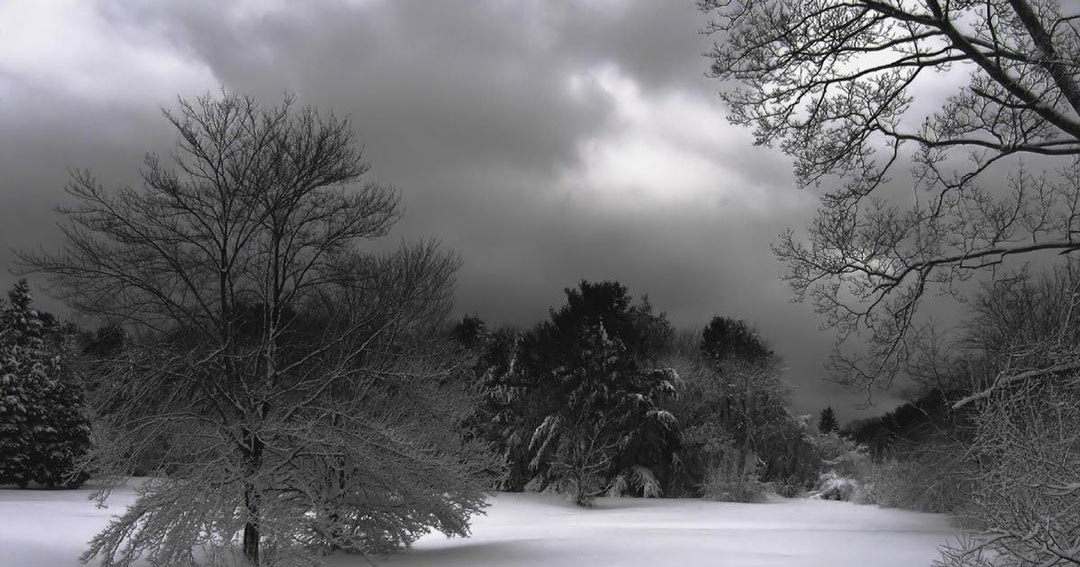
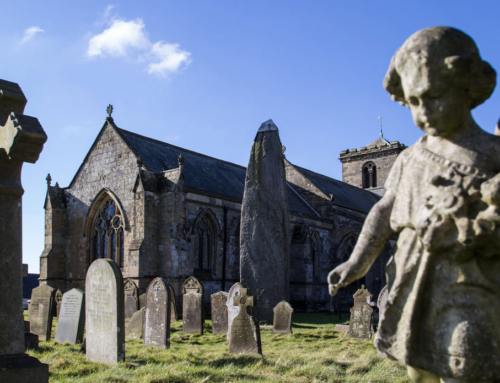
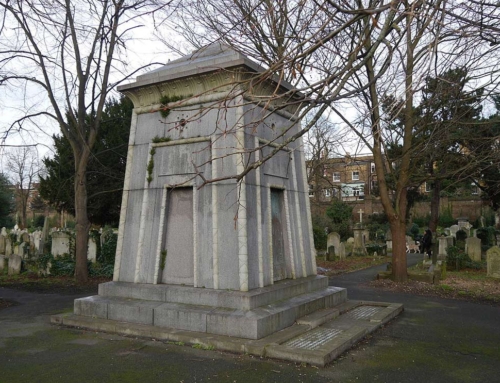
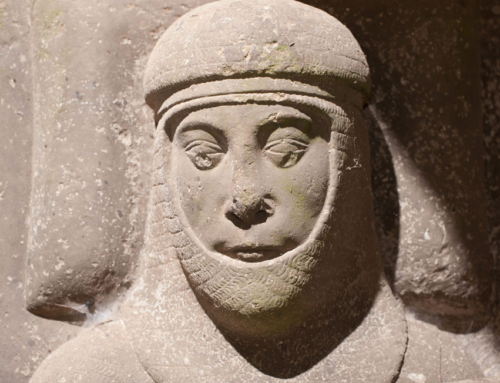
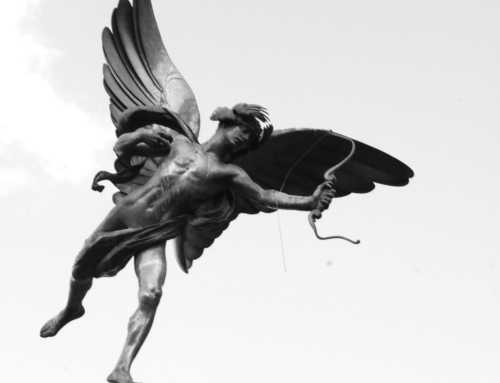
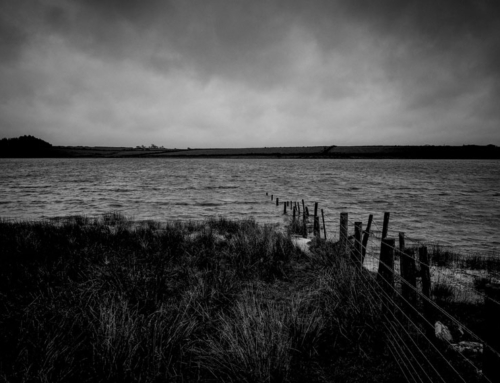
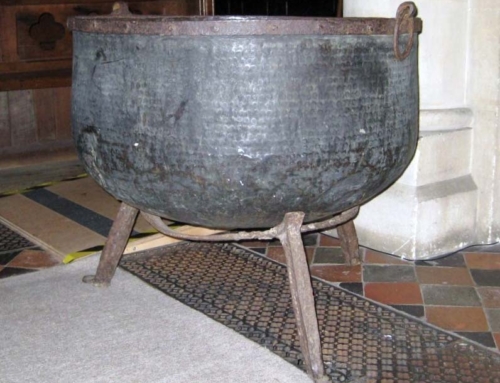
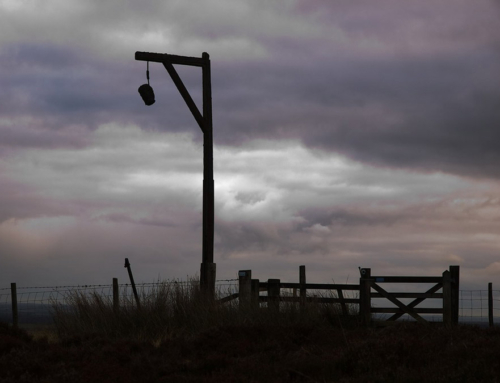
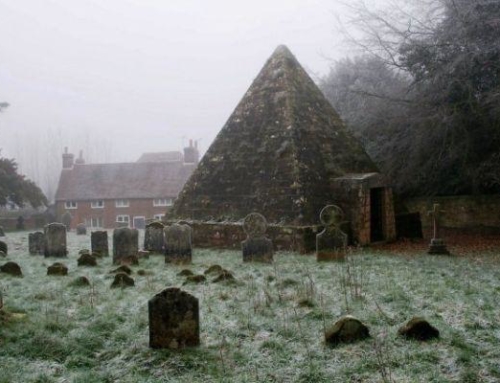
David, I remember this story from when I was a child. My parents had a Reader’s Digest book called something like Mysteries of the Unexplained and I read about it there (along with stories of Spring-heeled Jack and an “ancient” crystal skull). I write to my daughter each month about some unusual fact or fun story and was in the process of writing to her about the Devil’s Footsteps when I found your brilliant blog. Can’t wait to read more.
I came across a similar story in Manx Folklore of single lined footprints in the snow in a upland area near an ancient monument called
Castle of the Heights ! A tomb with the stones remaining !
the reason im at this point of my search for answers we recently have noticed in the deep snow undisturbed except for strange single hove prints that stop at one point them several feet away a single set of hoof prints that end no way its a deer only the the lone pair of prints with no further trail as if it took flight im going to investigate and attempt to get photos via a trail cam being how i have experience a strand sounding upright creature in the same area in the summer it was a creepy sound it made kinda like a quick squall heeeed sound the area is directly behind my home i live in a rural area and am going to get to the bottom of it via trail cam
yes bob im with u . ive commented below. the tracks were too straight to be a horse & would start & stop . weird https://www.bbc.co.uk/news/uk-scotland-50262655
i have seen tracks like these early one Christmas morning about 1987 , on a beach in Shoeburyness , in Essex, As it was Christmas, the tracks were noticeable as it was very quiet & they came from the mudflats as the tide was out. The tracks, which looked like elongated horse shoe prints, went all the way along the beach, not altering despite going over a breakwater fence (about 5 ft high) , then back out to the floods. i did get photos which i showed to the coastguard guy who’d been there for many years but no explanation other than perhaps a lobster pot. I would say Ploughman’s horses would be the closest description though that doesnt explain the fence hopping or indeed the mudflats – it wouldnt be a good idea to ride there . Never explained , although there was a story of a Yorkshire farmer who had seen a strange craft – like a ball on stilts that he reported seeing that left the same tracks. After his report aka Dechmont Woods incident, he froze up but it wouldve explained my sighting
Thanks, JD, fascinating story. It would be great to know more about the strange craft the Yorkshire farmer saw.